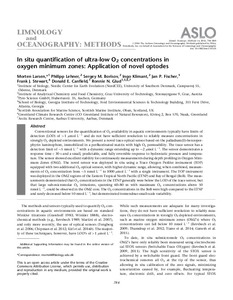| dc.contributor.author | Larsen, M. | |
| dc.contributor.author | Lehner, P. | |
| dc.contributor.author | Borisov, S.M. | |
| dc.contributor.author | Klimant, I. | |
| dc.contributor.author | Fischer, J.P. | |
| dc.contributor.author | Stewart, F.J. | |
| dc.contributor.author | Canfield, D.E. | |
| dc.contributor.author | Glud, R.N. | |
| dc.date.accessioned | 2019-05-13T20:56:10Z | |
| dc.date.available | 2019-05-13T20:56:10Z | |
| dc.date.issued | 2016 | |
| dc.identifier.citation | Larsen, M.; Lehner P.; Borisov, S.M.; Klimant, I.; Fische, J.P.; Stewart, F.J.; Canfield, D.E.; and Glud, R.N. (2016) In situ quantification of ultra-low O2 concentrations in oxygen minimum zones: Application of novel optodes. Limnology and Oceanography Methods, 14, pp.784-800. DOI:https://doi.org/10.1002/lom3.10126 | en_US |
| dc.identifier.uri | http://hdl.handle.net/11329/928 | |
| dc.identifier.uri | http://dx.doi.org/10.25607/OBP-469 | |
| dc.description.abstract | Conventional sensors for the quantification of O2 availability in aquatic environments typically have limits of detection (LOD) of > 1 μmol L−1 and do not have sufficient resolution to reliably measure concentrations in strongly O2 depleted environments. We present a novel trace optical sensor based on the palladium(II)‐benzoporphyrin luminophore, immobilized in a perfluorinated matrix with high O2 permeability. The trace sensor has a detection limit of ∼5 nmol L−1 with a dynamic range extending up to ∼2 μmol L−1. The sensor demonstrates a response time < 30 s and a small, predictable, and fully reversible response to hydrostatic pressure and temperature. The sensor showed excellent stability for continuously measurements during depth profiling in Oxygen Minimum Zones (OMZ). The novel sensor was deployed in situ using a Trace Oxygen Profiler instrument (TOP) equipped with two additional O2 optical sensors, with higher dynamic range, allowing, when combined, measurements of O2 concentration from ∼5 nmol L−1 to 1000 μmol L−1 with a single instrument. The TOP instrument was deployed in the OMZ regions of the Eastern Tropical North Pacific (ETNP) and Bay of Bengal (BoB). The measurements demonstrated that O2 concentrations in the ETNP generally were below the LOD of the trace sensor, but that large sub‐micromolar O2 intrusions, spanning 60–80 m with maximum O2 concentrations above 50 nmol L−1, could be observed in the OMZ core. The O2 concentrations in the BoB were high compared to the ETNP and rarely decreased below 50 nmol L−1, but demonstrated tremendous small‐scale variability. | en_US |
| dc.language.iso | en | en_US |
| dc.rights | Attribution 4.0 | * |
| dc.rights.uri | http://creativecommons.org/licenses/by/4.0/ | * |
| dc.title | In situ quantification of ultra-low O2 concentrations in oxygen minimum zones: Application of novel optodes. | en_US |
| dc.type | Journal Contribution | en_US |
| dc.description.refereed | Refereed | en_US |
| dc.format.pagerange | pp.784-800 | en_US |
| dc.identifier.doi | https://doi.org/10.1002/lom3.10126 | |
| dc.subject.parameterDiscipline | Parameter Discipline::Chemical oceanography | en_US |
| dc.bibliographicCitation.title | Limnology and Oceanography Methods | en_US |
| dc.bibliographicCitation.volume | 14 | en_US |
| dc.description.eov | Oxygen | en_US |
| dc.description.bptype | Standard Operating Procedure | en_US |
| obps.contact.contactemail | mortenl@biology.sdu.d | |
| obps.resourceurl.publisher | https://aslopubs.onlinelibrary.wiley.com/doi/full/10.1002/lom3.10126 | en_US |
 Repository of community practices in Ocean Research, Applications and Data/Information Management
Repository of community practices in Ocean Research, Applications and Data/Information Management

